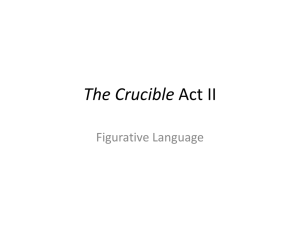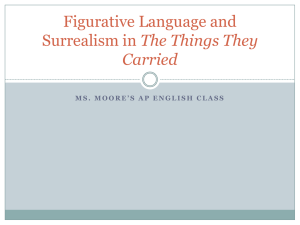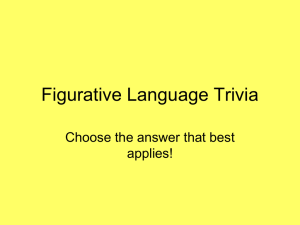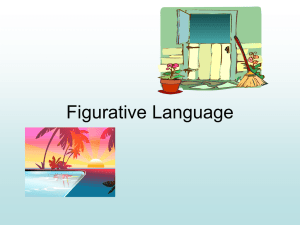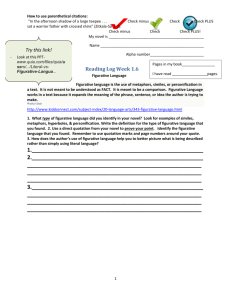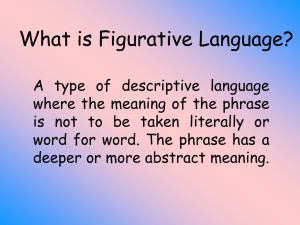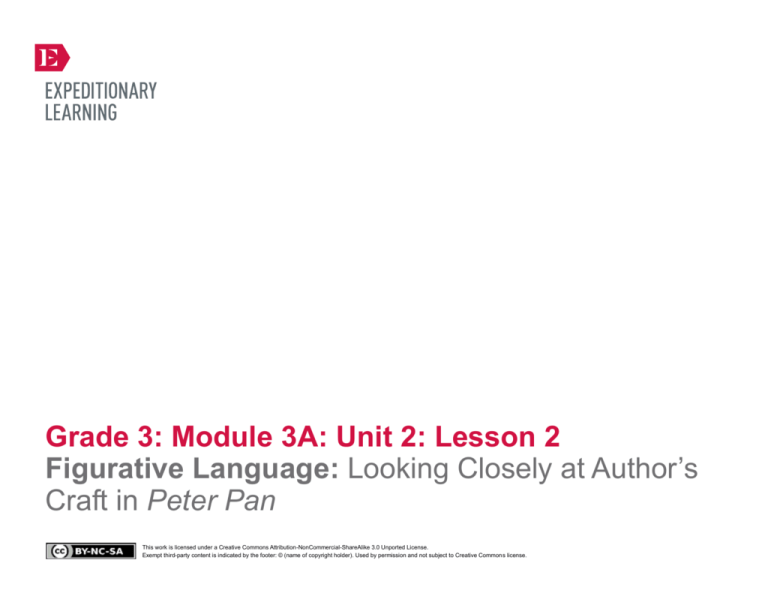
Grade 3: Module 3A: Unit 2: Lesson 2
Figurative Language: Looking Closely at Author’s
Craft in Peter Pan
This work is licensed under a Creative Commons Attribution-NonCommercial-ShareAlike 3.0 Unported License.
Exempt third-party content is indicated by the footer: © (name of copyright holder). Used by permission and not subject to Creative Commons license.
GRADE 3: MODULE 3A: UNIT 2: LESSON 2
Figurative Language:
Looking Closely at Author’s Craft in Peter Pan
Long-Term Targets Addressed (Based on NYSP12 ELA CCLS)
I can analyze the meaning of figurative language and complex words/word relationships. (L.3.5)
I can describe the difference between literal and nonliteral meaning of words and phrases in context. (L.3.5)
Supporting Learning Target
Ongoing Assessment
• I can analyze the meaning of figurative language in Peter Pan.
• Conferring notes during independent reading
Agenda
Teaching Notes
1. Opening
• In advance: Prepare the Figurative Language anchor chart with the T-chart and the quote in the lefthand column written out (see model in the supporting materials). Leave the right-hand column blank.
Using the Figurative Language anchor chart as a model, create similar T-charts for each quote. There
should be a separate T-chart for each excerpt on the Carousel of Quotes page (see supporting materials).
A. Engaging the Writer (5 minutes)
B. Unpacking Learning Target (5 minutes)
2. Work Time
A. Mini Lesson: Determining the Meaning of
Figurative Language (10 minutes)
• In advance: distribute five sticky notes to each student at their tables.
• Post: Learning targets.
B. Carousel of Quotes: Figurative Language in Peter
Pan (15 minutes)
C. Independent Reading: Peter Pan Chapter 10 (20
minutes)
3. Closing and Assessment
A. Where/Who/What Anchor Chart (5 minutes)
4. Homework
A. Reread Chapter 10 of your Peter Pan book at home,
either aloud in a mirror or to a family member. Point
out figurative language to someone at home, explaining
what the author really means.
Copyright © 2013 by Expeditionary Learning, New York, NY. All Rights Reserved.
NYS Common Core ELA Curriculum • G3:M3A:U2:L2 • June 2014 • 1
GRADE 3: MODULE 3A: UNIT 2: LESSON 2
Figurative Language:
Looking Closely at Author’s Craft in Peter Pan
Lesson Vocabulary
Materials
analyze, figurative, literal
• Figurative Language anchor chart (new; teacher-created; see Teaching Notes)
• Carousel of Quotes (for teacher reference; see Teaching Notes)
• Sticky notes (five per student)
• Classic Starts edition of Peter Pan (book; one per student)
• Where/Who/What anchor chart (begun in Unit 1)
Opening
Meeting Students’ Needs
A. Engaging the Writer (5 minutes)
• Invite students to the whole group area. Consider engaging them in today’s learning with a common use of figurative
language with which they may already be familiar. For example:
• Consider charting the “raining cats
and dogs” example to help visual
learners better understand the
concept of figurative language.
* “When I was growing up, my mother used to always say, ‘It’s raining cats and dogs outside!’ I can remember trying to
picture this in my mind, cats and dogs actually falling from the sky. Can you imagine that?”
• Invite students to Think-Pair-Share:
* “What does the phrase ‘it’s raining cats and dogs’ actually mean?”
• Invite whole-class shares using a total participation technique, such as cold call or equity sticks.
B. Unpacking Learning Target (5 minutes)
• Tell students that today they will be learning about how authors use lots of figurative language, such as “it’s raining cats and
dogs,” to help capture their readers’ imaginations. Invite them to read today’s learning target:
* “I can analyze the meaning of figurative language in Peter Pan.”
• Remind students of the meaning of the word analyze, which they have seen before when looking at characters. It means to
“examine carefully.” Review the meaning of figurative. Consider relating this to the phrase “figure of speech.”
Copyright © 2013 by Expeditionary Learning, New York, NY. All Rights Reserved.
NYS Common Core ELA Curriculum • G3:M3A:U2:L2 • June 2014 • 2
GRADE 3: MODULE 3A: UNIT 2: LESSON 2
Figurative Language:
Looking Closely at Author’s Craft in Peter Pan
Meeting Students’ Needs
Work Time
A. Mini Lesson: Determining the Meaning of Figurative Language (10 minutes)
• Direct students’ attention to the Figurative Language anchor chart. Tell them that you will use this chart and their
matching recording forms to collect examples of figurative language from Peter Pan, and then determine what these
examples actually mean.
• Read together the example from page 17:
* “Wendy’s light went out first. It yawned and, yawns being contagious, the other two lights promptly yawned as well. Then,
before any of the other lights could close their mouths, all three went out from the resulting breeze.”
• Invite students to Think-Pair-Share:
* “How is this language figurative? In other words, which part of this section did not really happen?”
• Listen in on student conversations, and then invite a whole-class share that sounds like: “Lights can’t actually yawn. They
don’t have mouths!”
• Explain that when authors use figurative language, they usually have a literal meaning. Define the word literal as “true to
fact, or what actually happened.”
• Invite students to Think-Pair-Share:
* “So, what was the author’s literal meaning when saying the light ‘yawned’ or ‘before any of the other lights could close
their mouths, all three went out from the resulting breeze’?”
• Invite whole-class shares, listening for examples such as: “It means the lights went out.”
• On a sticky note, write “The lights went out” and stick it in the Literal Meaning column of the anchor chart. Collect one or
two more examples, such as “there was wind” to show that figurative language can be interpreted in multiple ways.
Copyright © 2013 by Expeditionary Learning, New York, NY. All Rights Reserved.
NYS Common Core ELA Curriculum • G3:M3A:U2:L2 • June 2014 • 3
GRADE 3: MODULE 3A: UNIT 2: LESSON 2
Figurative Language:
Looking Closely at Author’s Craft in Peter Pan
Work Time (continued)
Meeting Students’ Needs
B. Carousel of Quotes: Figurative Language in Peter Pan (15 minutes)
• Tell students they will now read, think, talk, and write about other figurative language they have seen in Peter Pan but
perhaps did not notice. Distribute sticky notes and give students these directions:
• Consider posting written directions
for the Carousel of Quotes to help
students keep track of multistep
directions.
1. Each group will begin at a different chart around the room. A quote from Peter Pan that includes figurative language will
top each chart.
2. Read the quote with your group. At each chart, a new person should take a turn reading the quote aloud.
3. Think about what the figurative language actually means.
4. Talk about it with your group.
5. On a sticky note, write your idea for what this excerpt literally means.
6. When directed, rotate to the next chart that has a new excerpt.
• Figurative language presents unique
challenges for ELLs and often must
be taught directly. Consider pulling
select students into a small group
and giving them direct instruction
and support in interpreting these
quotes.
• As students rotate, circulate and support them in their discussions and their writing. This might include guiding them
through their translation of figurative language or assisting them in succinctly writing their sticky note to add to the chart.
• After 15 minutes, gather students back in the whole group meeting area. Review the figurative language excerpts they looked
at, using this discussion time to clear up any confusion or misconceptions about their literal meanings. Add these examples
to the Figurative Language anchor chart.
• Invite students to Think-Pair-Share:
* “How does using figurative language help authors to capture a reader’s imagination?”
C. Independent Reading: Peter Pan Chapter 10 (20 minutes)
• Invite students to get out their Peter Pan book and tell them they will have the next 15 minutes to sit with their reading
partners and read Chapter 10 (“The Never Bird”).
• Circulate and support students as they read. Consider taking conferring notes on individual students (either fluency or
comprehension) to continue to informally assess.
Copyright © 2013 by Expeditionary Learning, New York, NY. All Rights Reserved.
NYS Common Core ELA Curriculum • G3:M3A:U2:L2 • June 2014 • 4
GRADE 3: MODULE 3A: UNIT 2: LESSON 2
Figurative Language:
Looking Closely at Author’s Craft in Peter Pan
Meeting Students’ Needs
Closing and Assessment
A. Where/Who/What Anchor Chart (5 minutes)
• Invite students back to the whole group area. Direct their attention to the Where/Who/What anchor chart. Ask them to
share with the whole class their ideas for the important characters, events, and settings in this chapter.
Meeting Students’ Needs
Homework
• Reread Chapter 10 of your Peter Pan book at home, either aloud in a mirror or to a family member. Point out figurative
language to someone at home, explaining what the author really means.
Copyright © 2013 by Expeditionary Learning, New York, NY. All Rights Reserved.
NYS Common Core ELA Curriculum • G3:M3A:U2:L2 • June 2014 • 5
Grade 3: Module 3A: Unit 2: Lesson 2
Supporting Materials
This work is licensed under a Creative Commons Attribution-NonCommercial-ShareAlike 3.0 Unported License.
Exempt third-party content is indicated by the footer: © (name of copyright holder). Used by permission and not subject to Creative Commons license.
GRADE 3: MODULE 3A: UNIT 2: LESSON 2
Figurative Language Anchor Chart:
(For Teacher Reference)
Learning target: I can analyze the meaning of figurative language in Peter Pan.
Figurative language from Peter Pan
“Wendy’s light went out first. It yawned and,
yawns being contagious, the other two lights
promptly yawned as well. Then, before any of the
other lights could close their mouths, all three
went out from the resulting breeze.”
Copyright © 2013 by Expeditionary Learning, New York, NY. All Rights Reserved.
Literal meaning: What does the author really
mean by this?
The lights went out.
A breeze made the candles blow out.
NYS Common Core ELA Curriculum • G3:M3A:U2:L2 • June 2014 • 7
GRADE 3: MODULE 3A: UNIT 2: LESSON 2
Carousel of Quotes
(For Teacher Reference)
Below are excerpts from the Classic Starts edition of Peter Pan that include figurative language.
Page 15:
“Night-lights are the eyes a mother leaves behind at night to watch over her babies.”
Page 41:
“Neverland seemed to sense that Peter was almost home. Like a puppy, it strained and
wiggled to meet him at the door.”
Page 72:
“They cut Tiger Lily’s cords, and with one last look she slid into the water like a
graceful eel.”
Page 82:
“He heard the water gurgle greedily as it rose to nibble on the rock.”
Page 96:
“Finished with the Indians, the pirates still could not rest. It was, after all, not the
Indians they had come for. The Indians were just bees to be smoked out so they could
get to the honey.”
Copyright © 2013 by Expeditionary Learning, New York, NY. All Rights Reserved.
NYS Common Core ELA Curriculum • G3:M3A:U2:L2 • June 2014 • 8



